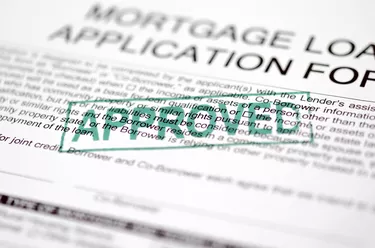
Pulling back the curtain on the mortgage underwriting process can help you gather the right documents and ensure loan approval. Underwriting allows the lender to verify that you're financially capable of repaying the loan and that the mortgaged home meets lender criteria. Discrepancies between your loan application and supporting documents or unverifiable details can delay mortgage approval, and may even cause the underwriter to reject the loan.
Underwriters Manually Verify Information
Video of the Day
A loan officer likely helped with the mortgage loan application, collected a few preliminary documents, such as pay stubs, and ran your credit to ensure you met basic requirements. She may also have put your information through an automated underwriting system. Automated underwriting software provides loan pre-approval based solely on details you and the loan originator input. Because it doesn't involve review of supporting documents, a manual underwriter -- an individual working for the lender -- must still review these "by hand" before fully approving the loan.
Video of the Day
Confirming Your Income
Underwriters calculate a debt-to-income ratio, or DTI -- a percentage that represents your debt load in relation to your gross income. They make sure you earn enough to make your monthly payments, including the mortgage. Underwriters only count verifiable income in your DTI, so if your employer doesn't vouch for your earnings or you don't report income to the IRS, the lender may not consider it income. If the underwriter determines you make less income than you put on the application, it can lower the amount you're able to borrow.
Verifying Your Employment
Underwriters contact your employer to verify your income and employment status. This step, known as a verification of employment, may involve a phone call to your job's human resources department. It may involve a fax or e-mail to your supervisor or another higher-up asking them to complete and sign a VOE request. Underwriters may also cross reference employment information you provided with your most recent income tax returns or the employment history listed on your credit report. When verifying employment, they may ask about your:
- hourly rate or salary
- full-time or part-time status
- dates of employment
- the likelihood of continued employment
- your position or title.
Determining Your Debt
Your credit score serves as a benchmark for qualifying, but underwriters also review accounts on your credit report. Even if your credit score meets the lender's requirements, accounts in collection, or payments past-due for 30 days or more in the last year, may cause your loan to be rejected. However, lenders might exercise some flexibility when it comes to credit challenges. For example, the underwriter may require you to pay off a collection account or require a letter of explanation regarding past-due payments if you meet all other lending requirements.
Checking Out the House
Lenders require a home appraisal to determine whether a home meets requirements for collateral. An underwriters review the appraisal report to verify the home is worth an acceptable amount and to check for conditions that would affect future marketability, such as structural problems. Lenders usually lend only a percentage of a home's value, such as 80 percent, and the appraisal tells the underwriter whether the home meets loan-to-value requirements.